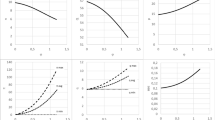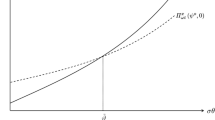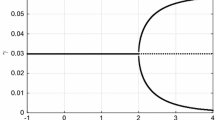Abstract
This paper is in general concerned with the role of firm heterogeneity for economic growth. We focus on heterogeneous productivity in innovation and credit constraints of firms within a semi-endogenous growth model reflecting recent empirical findings on firm heterogeneity. Our model allows for an explicit solution for transitional growth and for the balanced growth path level of innovations or ideas. The model predicts an optimal degree of heterogeneity in the presence of an endogenous firm distribution. This enables us to draw inference about the impact of key policy parameters of the model on these quantities and to draw conclusions about firm and capital market related policies.
Similar content being viewed by others
References
Acs ZJ, Audretsch DB (1987) Innovation in large and small firms. Econ Lett 23: 109–112
Acs ZJ, Audretsch DB (1988) Innovation in large and small firms: an empirical analysis. Am Econ Rev 78: 678–690
Acs ZJ, Audretsch DB (1990) Innovation and small firms. MIT Press, Cambridge
Acs ZJ, Audretsch DB (1991) R&D, firm size, and innovative activity. In: Acs ZJ, Audretsch DB (eds) Innovation and technological change: an international comparison. Harvester Wheatsheaf, New York
Aghion P, Howitt P (1992) A model of growth through creative destruction. Econometrica 60: 323–351
Aghion P, Howitt P (1998) Endogenous growth theory. MIT Press, New York
Aghion P, Bond S, Klemm A, Marinescu I (2004) Technology and financial structure: are innovative firms different?. J Eur Econ Assoc 2: 277–288
Aghion P, Fally T, Scarpetta S (2007) Credit constraints as a barrier to the entry and post-entry growth of firms. Econ Policy 52: 731–779
Almeida H, Campello M (2004) Financial constraints, asset tangibility, and corporate investment. Rev Financ Stud 20: 1429–1460
Altman EI, Sabato G (2005) Effects of the new basel capital accord on bank capital requirements for SMEs. J Financ Serv Res 28: 15–42
Angelini P, Generale A (2008) On the evolution of firm size distributions. Am Econ Rev 98: 426–438
Audretsch DB (2007) From small business promotion to creating an entrepreneurial society. CESifo Forum 8(2): 3–6
Audretsch DB, Keilbach MC (2004) Entrepreneurship and regional growth: an evolutionary interpretation. J Evol Econ 14: 605–616
Audretsch DB, Thurik AR (2001) Linking entrepreneurship to growth. OECD Science, Technology and Industry Working Papers 2001/2
Ayyagari M, Demirgüc-Kunt A, Beck T (2007) Small and medium enterprises across the globe. Small Bus Econ 29: 415–434
Baldwin RE, Robert-Nicoud F (2008) Trade and growth with heterogeneous firms. J Int Econ 74: 21–34
Beck T, Demirgüç-Kunt A, Laeven L, Maksimovic V (2006) The determinants of financing obstacles. J Int Money Finance 25: 932–952
Berger AN (2006) Potential competitive effects of basel II on banks in SME credit markets in the United States. J Financ Serv Res 29: 5–36
Bernanke BS, Gertler M, Gilchrist S (1996) The financial accelerator and the flight to quality. Rev Econ Stat 78: 1–15
Bernanke BS, Gertler M, Gilchrist S (1999) The financial accelerator in a quantitative business cycle framework. In: Taylor JB, Woodford M (eds) Handbook of macroeconomics, 1st edn, vol 1, chap 21, pp 1341–1393
Bertschek I, Entorf H (1996) On nonparametric estimation of the Schumpeterian link between innovation and firm size. Empir Econ 21: 401–426
BIS (2009) Strengthening the resilience of the banking sector. Bank for International Settlements, Basel
Bond E, Tybout JR, Utar H (2008) Credit rationing, risk aversion and industrial evolution in developing countries. NBER Working Paper No. 14116
Bound JC, Cummins C, Griliches Z, Hall BH, Jaffe A (1984) Who does R&D and who patents. In: Griliches Z R&D, patents and productivity. University Press, Chicago
Cabral LMB, Mata J (2003) On the evolution of the firm size distribution: facts and theory. Am Econ Rev 93: 1075–1090
Carree MA, Thurik AR (1998) Small firms and economic growth in Europe. Atl Econ J 26: 137–146
Cohen WM, Klepper S (1996) A reprise of size and R&D. Econ J 106: 925–951
Cohen W, Levinthal D (1990) Absorptive capacity: a new perspective on learning and innovation. Adm Sci Q 35: 128–152
Cremer J, Sirbu M (1978) Une analyse econometrique de l’effort de recherché et developpement de l’industrie Francaise. Revue Economique 29: 940–954
Czarnitzki D, Hottenrott H (2011) R&D investment and financing constraints of small and medium-sized firms. Small Bus Econ 36: 65–83
Dannreuther C (2007) EU SME policy: on the edge of governance. CESifo Forum 8(2): 7–13
Devereux M, Schiantarelli F (1990) Investment, financial factors and cash flow from U.K. Panel Data. In: Hubbard G (ed) Information, capital markets and investment. University of Chicago Press
EC (2010) Lisbon strategy evaluation document. Commission Staff Working Document, Brussels
ECB (2009) The Euro area bank lending survey—January 2009. European Central Bank, Frankfurt
Entorf H (1988) Die endogene Innovation. Eine mikro-empirische Analyse von Produktphasen als Innovationsindikatoren. Jahrbücher für Nationalökonomie und Statistik 204: 175–189
Gale D, Hellwig M (1985) Incentive-compatible debt contracts: the one-period problem. Rev Econ Stud 52: 647–663
Gertler M (1988) Financial structure and aggregate economic activity: an overview. J Money Credit Bank 20: 559–596
Gorodnichenko Y, Schnitzer M (2010) Financial constraints and innovation: why poor countries don’t catch up. CEPR Working Paper No. 7721
Greenwald BC, Stiglitz JE (1987) Imperfect information, credit markets and unemployment. Eur Econ Rev 31: 444–456
Grunert J, Kleff V, Norden L, Weber M (2002) Mittelstand und Basel II: Der Einfluss der neuen Eigenkapitalvereinbarung für Banken auf die Kalkulation von Kreditzinsen. Zeitschrift für Betriebswirtschaft, ZfB, 10/2002, 1–20
Hall BH, Jaffe A, Trajtenberg M (2005) Market value and patent citations. RAND J Econ 36: 16–38
Helpman E, Itskhoki O, Redding S (2008) Wages, unemployment and inequality with heterogenous firms and workers. NBER Working Paper No. 14122
Hurst E, Lusardi A (2004) Liquidity constraints, household wealth, and entrepreneurship. J Political Econ 112: 319–347
Idson TL, Oi WY (1999) Workers are more productive in large firms. Am Econ Rev 89: 104–108
Jacobson T, Lindé J, Roszbach K (2005) Credit risk versus capital requirements under Basel II: are SME loans and retail credit really different?. J Financ Serv 28: 43–75
Jones CI (1995) R&D-based models of economic growth. J Political Econ 103: 759–784
Jones CI (1999) Growth: with or without scale effects?. Am Econ Rev: Papers Proc 89: 139–144
Jones CI (2005) Growth and ideas. In: Aghion P, Durlauf S (eds) Handbook of economic growth. North-Holland
Jousten A (2007) SMEs and the tax system: what is so different about them?. CESifo Forum 8(2): 14–20
Klees S, Veldhues B (2008) Ausgewählte Ergebnisse für kleine und mittlere Unternehmen in Deutschland 2005. Statistisches Bundesamt—Wirtschaft und Statistik 3/2008
Klette TJ, Kortum S (2004) Innovating firms and aggregate innovation. J Political Econ 112: 986–1018
Lelarge C, Sraer D, Thesmar D (2010) Entrepreneurship and credit constraints: evidence from a French loan guarantee program. In: Lerner J, Schoar A (eds) International differences in entrepreneurship. NBER Books, National Bureau of Economic Research Inc
Lotti F, Schivardi F (2005) Cross country differences in patent propensity: a firm-level investigation. Giornale degli Economisti e Annali di Economia 64: 469–502
Luttmer GJ (2007) Selection, growth, and the size distribution of firms. Q J Econ 122: 1103–1144
Mata J (1996) Markets, entrepreneurs and the size of new firms. Econ Lett 52: 89–94
Michelacci C, Quadrini V (2005) Borrowing from employees: wage dynamics with financial constraints. J Eur Econ Assoc 3: 360–369
Michelacci C, Quadrini V (2009) Financial markets and wages. Rev Econ Stud 76: 795–827
Musso P, Schiavo S (2008) The impact of financial constraints on firm survival and growth. J Evol Econ 18: 135–149
Nelson RR, Phelps ES (1966) Investment in humans, technological diffusion and economic growth. Am Econ Rev 56: 67–75
Nelson RR, Winter SG (1973) Toward an evolutionary theory of economic capabilities. Am Econ Rev 63: 440–449
OECD (2009) Turin Round Table Meeting on the impact of the global crisis on SME & entrepreneurship financing and policy responses. Chairs summary. http://www.oecd.org/dataoecd/36/27/42514077.pdf
Pagano P, Schivardi F (2003) Firm size distribution and growth. Scand J Econ 105: 255–274
Papageorgiou C (2003) Imitation in a non-scale R&D growth model. Econ Lett 80: 287–294
Pavitt K, Robson M, Townsend J (1987) The size distribution of innovation firms in the UK: 1945–1983. J Ind Econ 35: 297–317
Peretto PF (1998) Technological change, market rivalry, and the evolution of the capitalist engine of growth. J Econ Growth 3: 53–80
Peretto PF (1999a) Cost reduction, entry, and the interdependence of market structure and economic growth?. J Monet Econ 43(1): 173–195
Peretto PF (1999b) Firm size, rivalry and the extent of the market in endogenous technological change. Eur Econ Rev 43(9): 1747–1773
Plehn-Dujowich J (2007) Innovation, firm size, and RDSearch. Econ Bull 12: 1–8
Saurina J, Trucharte C (2004) The impact of Basel II on lending to small- and medium-sized firms: a regulatory policy assessment based on Spanish Credit Register Data. J Financ Serv Res 26: 121–144
Scellato G (2007) Patents, firm size and financial constraints: an empirical analysis for a panel of Italian manufacturing firms. Camb J Econ 31: 55–76
Townsend RM (1979) Optimal contracts and competitive markets with costly state verification. J Econ Theory 21: 265–293
Verspagen B (1999) Large firms and knowledge flows in the Dutch R&D system: a case study of Philips electronics. Technol Anal Strateg Manag 11: 211–233
Wagenvoort R (2003a) Are finance constraints hindering the growth of SMEs in Europe. EIB Pap 7: 22–50
Wagenvoort R (2003b) SME finance in Europe: introduction and overview. EIB Pap 8: 10–20
Yeaple SR (2005) A simple model of firm heterogeneity, international trade, and wages. J Int Econ 65: 1–20
Author information
Authors and Affiliations
Corresponding author
Rights and permissions
About this article
Cite this article
Antony, J., Klarl, T. & Maußner, A. Firm heterogeneity, credit constraints, and endogenous growth. J Econ 105, 199–224 (2012). https://doi.org/10.1007/s00712-011-0225-9
Received:
Accepted:
Published:
Issue Date:
DOI: https://doi.org/10.1007/s00712-011-0225-9




